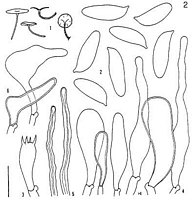|
 Marasmius pusillissimus Marasmius pusillissimus
BiostatusPresent in region - Indigenous. Endemic
Images (click to enlarge)
Caption: Marasmius pusillissimus Desjardin & Petersen (PDD; ZT 849): 1, basidiomes (x2);
2, basidiospores (x2000); 3, basidium (xI000);
4, pileipellis with pilocystidia (xl000);
5, marginal 'hairs' on margin of pileus (xl000);
6, caulocystidi | 
Caption: Marasmius pusillissimus. A, Basidiomata (x10). B, Basidiospores (x2000). C, Basidia and basidioles.
D, Hymenial cystidia. E, Pileipellis elements. F, Caulocystidia. (C-F x1000) |
Article: Horak, E.; Desjardin, D.E. (1994). Reduced marasmioid and mycenoid agarics from Australasia. Australian Systematic Botany 7: 153-170.
Description: Description of Second New Zealand Record
Pileus to 3 mm, convex to flat-expanded,
old specimens also with depressed centre, subumbilicate, whitish, minutely pruinose,
margin subciliate. Lamellae none, hymenophore smooth or occasionally with a
few low radially arranged folds, whitish. Stipe to 4 X to 0.2 mm, central (rarely
eccentric), cylindrical, straight or curved, whitish to hyaline, minutely pruinose
overall, dry, solid, solitary in groups, insititious (byssus or basal disc absent).
Odour absent. Basidiospores 12-16 X 4.5-5.5 µm, subfusiform (reminiscent of
boletoid spores), inequilateral in profile, often with significant supra-apicular
depression, smooth, hyaline, inamyloid. Basidia 23-30 X 8-11 µm, tetrasporic,
subclavate, clamped. Hymenial cystidia inconspicuous, lageniform. Pileipellis
hymeniform, composed of subcylindric, clavate or broadly fusiform ceils, 30-60
X 8-20 µm, non-gelatinous walls up to 1µm diam., hyaline, smooth. Pilocystidia
scattered, up to 90 X up to l6 µm, fusiform with tapering, rounded neck, thin-walled,
hyaline. Margin of cap with scattered, bristle-like, cylindrical 'hairs', 3-7
µm diam., subgelatinous, conpicuously thick-walled (up to 3 µm diam.), with
distinctive lumen at apex, often encrusted with colourless matter. Oleiferous
hyphae absent. Stipe tissue monomitic. Stipe conical hyphae 3-8 µm diam., parallel,
cylindric, hyaline, smooth. Caulocystidia numerous, 15-50 X 8-18 µm, polymorphic,
ranging in shape from cylindric to broadly fusoid, walls up to 1.5 µm thick,
hyaline, clamped.
Habitat: On rotting leaves of Astelia sp. (Asteliaceae),
already infecting healthy leaves and consistently associated with leaf spots.
Known from North Island of New Zealand.
Notes: This represents a second New Zealand record
for this tiny species reported first from Waipoua Kauri Reserve, Hokianga Co.
(Desjardin and Petersen 1989).
The material described above differs slightly
from the holotype in showing larger pilei, longer pilocystidia, and the presence
of scattered bristle-like marginal hairs. Gloiocephala Massee, Grevillea 21:33(1892)
Article: Desjardin, D.E.; Petersen, R.H. (1989). Two new Marasmius species from New Zealand. New Zealand Journal of Botany 27(2): 275-279 (http://www.rsnz.org/publish/abstracts.php).
Description: Basidiomata marcescent. Pileus 0.5-l mm diam,
convex, expanding to plano-convex; surface even (non-striate), minutely granulose,
white. Lamellae absent; hymenophore smooth, white. Stipe 0.5-1 x 0.1 mm, central
or slightly eccentric, often curved, terete, equal, pruinose, insititious, white
overall. Odour and taste not recorded. Basidiospores 12.8-17.2 x 3.8-4.8 µm
[x = 14.7 x 4.2 µm, s = 1.3 x 0.3, E = 2.7-4.4, Q=3.5, sQ = 0.4, n = 20], subfusiform,
inequilateral in profile, hyaline, inamyloid, smooth. Basidia 24-32 x 6.5-8.0
µm, tetrasporic, cylindric or subclavate, hyaline, contents tawny in Melzer's
reagent. Basidioles clavate or ventricose. Hymenial cystidia ~32 x 10 µm, lageniform
or ampullaceous, non-refractive, hyaline, thin-walled or firm-walled (walls
up to 0.5 µm thick). Pileipellis hymeniform; elements up to 28 µm diam, smooth
(non-diverticulate), broadly clavate or vesiculose and short pedicellate, hyaline,
inamyloid; walls up to 1 µm thick; ventricose dermatocystidioid elements scattered,
scarcely projecting. Tramal hyphae 3-8(-13) µm diam, interwoven, hyaline, inamyloid,
non-gelatinous, clamped; walls <l µm thick. Stipe tissue monomitic. Stipe
cortical hyphae 3-10 µm diam, parallel, hyaline, inamyloid, smooth, clamped;
walls up to 2 µm thick. Stipe medullary hyphae similar but thin-walled. Caulocystidia
scattered, 4-16 x 6-9 µm, cylindric or clavate, thick-walled, hyaline, inamyloid.
Scattered on senescent monocotyledonous leaves (probably Astelia).
Notes: Marasmius pusillissimus
is characterised by minute, entirely white basidiomata that lack lamellae, pruinose,
insititious stipe, and growth on monocotyledonous leaves. In addition, inamyloid,
clamped tramal hyphae and long spores are distinctive. Although basidiomata
size, stature and reduced hymenophore suggest that this taxon should be looked
for in the cyphelloid series of the Tricholomataceae, several features indicate
that the species is best placed in Marasmius sect. Epiphylli Kuhner
subsect. Epiphyllini Singer. Characters which support this disposition
include: a) hymeniform pileipellis of smooth, non-diverticulate elements plus
scattered dermatocystidioid cells; b) inamyloid tramal hyphae with clamp connections;
c) ventricose-ampullaceous hymenial cystidia; d) absence of pigments; and e)
insititious stipe. Taxa in sect. Epiphylli show hymenophore development
ranging from well-developed lamellae to radiating folds or ridges, but few taxa
form hymenia entirely devoid of macroscopic differentiation. One such species
superficially similar to M. pusillissimus is M. martinii Singer
[ut M. martini (Singer, 1958) nom. nov. for Cymatella longipes
Martin (1944)]. Both M. pusillissimus and M. martinii form very
small, pigmentless pilei with entirely smooth hymenia. Marasmius martinii
differs in forming a longer (up to 16 mm) and darkly pigmented stipe (yellow-brown
or nearly black), shorter spores (9-11 µm), and in growing from bark of fallen
branches [fide Martin 1944; Singer 1965, 1976]. Marasmius martinii is known
only from Colombia, South America.
A second species superficially similar to
M. pusillissimus was described from Sierra Leone as Marasmius cymatelloides
Dennis & Reid (1957). Subsequently, Singer (1961) established the monotypic
genus Palaeocephala Singer based on the type specimen of M. cymatelloides.
Palaeocephala is closely allied with Gloiocephala Massee, a genus
considered by some as congeneric with Marasmius (see Bas 1961; Noordeloos
1981). Palaeocephala cymatelloides differs from M. pusillissimus
in having dextrinoid tramal hyphae, abundant basal mycelium (i.e., stipe non-insititious),
absence of hymenial cystidia, and in growing on leaves of Baphia pyrifolia
Baill. [Leguminosae] (fide Dennis & Reid 1957).
|